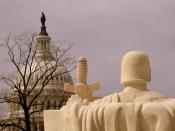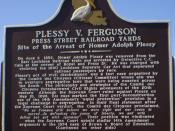The case of "Separate but Equal"
Segregation was a very normal part of life for unfortunately many years. Even after the Civil War had ended, separation of black and white citizens was very common. There were separate churches, schools, markets, busses, trains, and restaurants for African American communities. Starting in 1892, twenty-seven years after the Civil War, a man named, Mr. Homer Plessy, who was of mixed race, was thrown in jail because he refused to move to an exclusive all black railroad car, while riding on a train. This was the beginning of the "Separate but Equal" case.
When Mr. Plessy went to court, he argued that Congress was disobeying the thirteenth and fourteenth amendment, for forcing him to sit in an all black railroad car. The Supreme Court of the United States determined that if legislation made judgments based on race, but did not deny anyone of their rights or privileges, it was constitutional.
The court also stated, that this was not a violation of the amendments, because the rail system was state owned, and the national government had nothing to do with it. Overall, the Court decided that the common practice of separation was merely an inconvenience, not something that reduced the rights of African Americans. Unfortunately, Mr. Plessy was found guilty of the charge.
Many white Americans believed that it was okay for black and white people to be separated, as long as the facilities were of equal conditions. Although the Supreme Court stated that the separate facilities must be equal, many cases showed they were not. Black people were still treated unfairly. The white population still had nicer restrooms, schools, transportation, and living facilities. And unfortunately for more than 100 years after the Civil war, African American people continued to be treated unequally.


